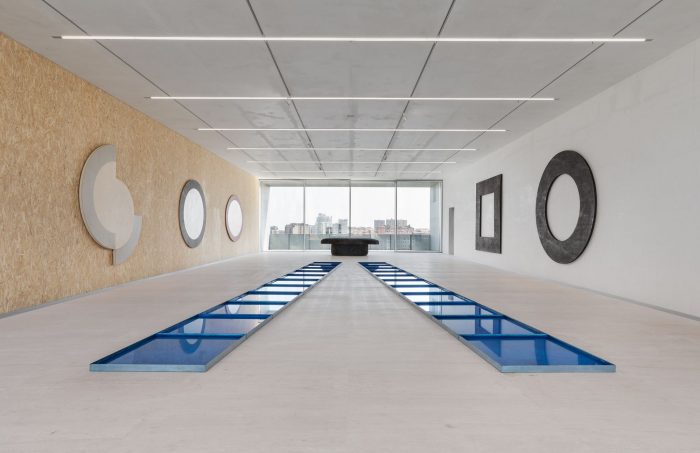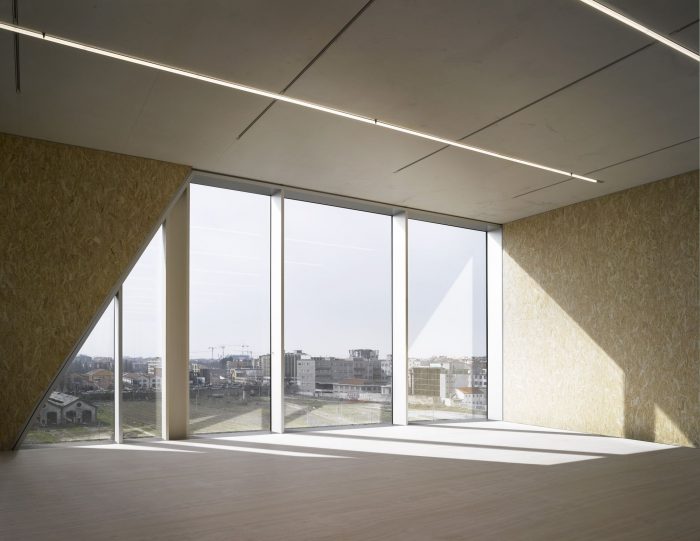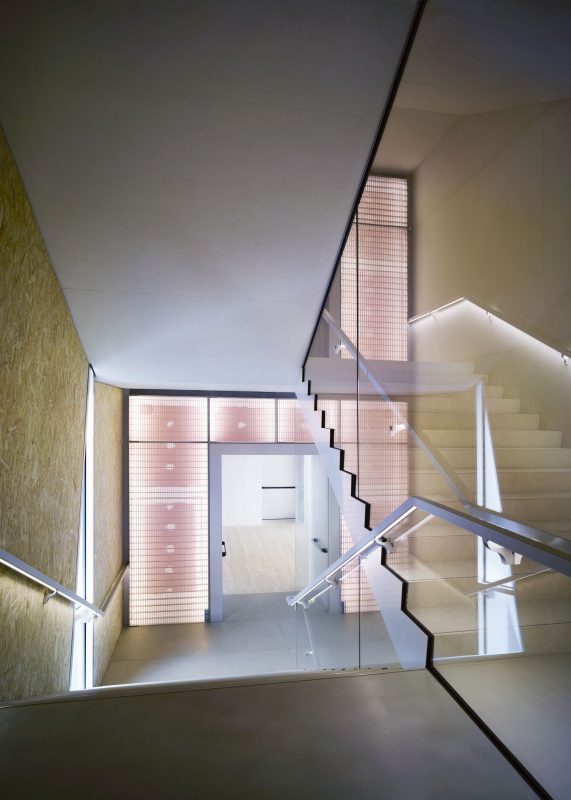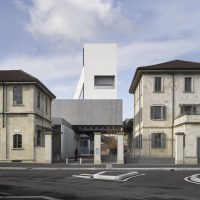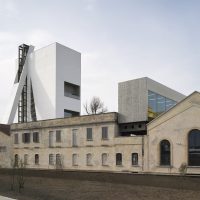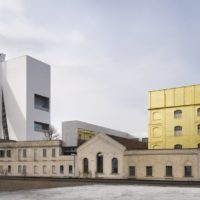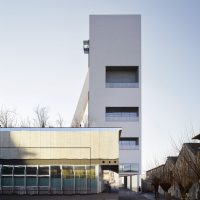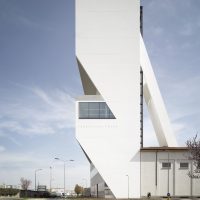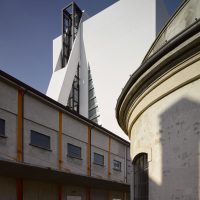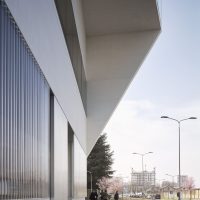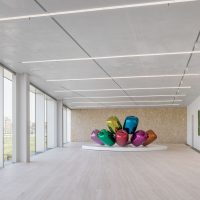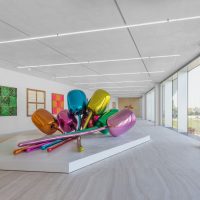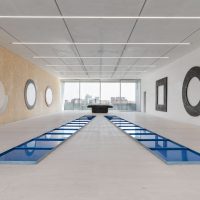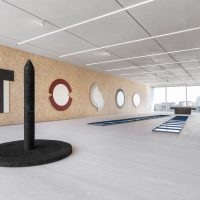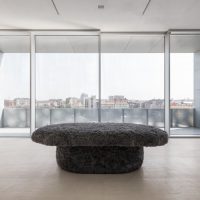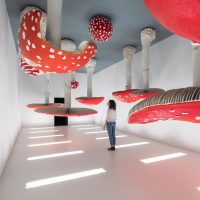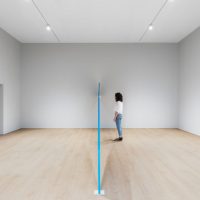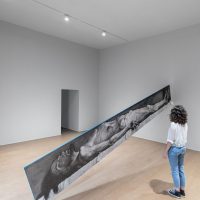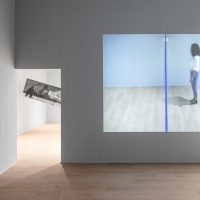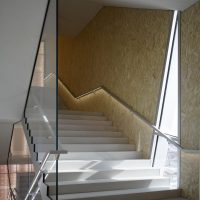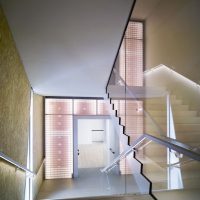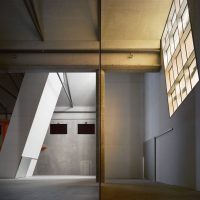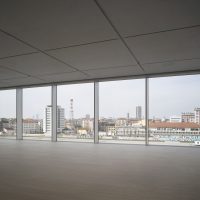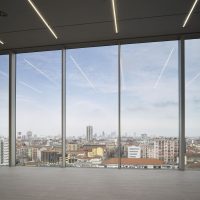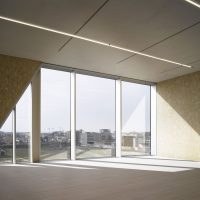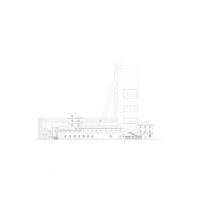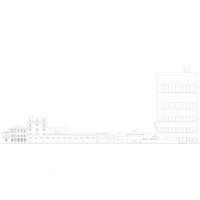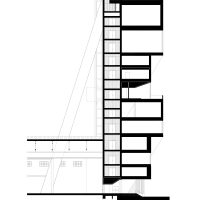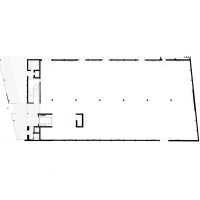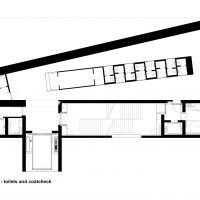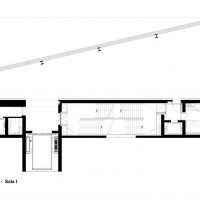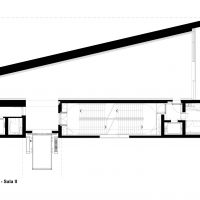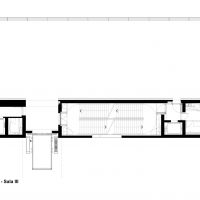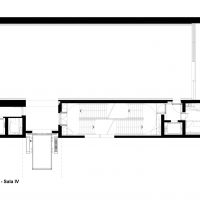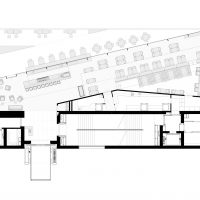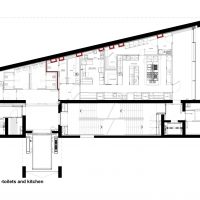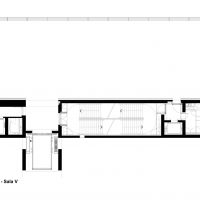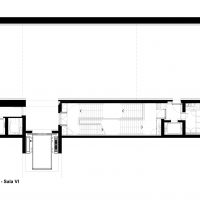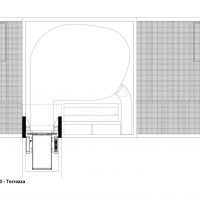Designed by OMA, The 60-meters high Torre is realized in exposed white concrete. The new building further develops the repertoire of different exhibition conditions that together define the architectural vision of the foundation, characterized by a variety of oppositions and fragments.
 Each of the nine floors of Torre offers an original perception of the internal environment thanks to a specific combination of three spatial parameters: plan dimension, clear height, and orientation. Half of the levels are in fact developed on a rectangular floor plan, while the other half displays a trapezoid one.
Each of the nine floors of Torre offers an original perception of the internal environment thanks to a specific combination of three spatial parameters: plan dimension, clear height, and orientation. Half of the levels are in fact developed on a rectangular floor plan, while the other half displays a trapezoid one.
The clear height of the ceilings increases from bottom to top, varying from 2,7 meters on the first floor to 8 meters on the top level. The external façades are characterized by an alternation of concrete and glass surfaces, which allows exposure from a northern, eastern or western side on the different floors, whereas the top gallery space is exposed to zenithal light.
 The southern side of Torre presents a diagonal structure connecting it to the Deposito, and inside which a panoramic elevator is integrated. As stated by Rem Koolhaas, “Together these variations produce a radical diversity within a simple volume – so that the interaction between the spaces and specific events or works of art offers an endless variety of conditions”.
The southern side of Torre presents a diagonal structure connecting it to the Deposito, and inside which a panoramic elevator is integrated. As stated by Rem Koolhaas, “Together these variations produce a radical diversity within a simple volume – so that the interaction between the spaces and specific events or works of art offers an endless variety of conditions”.
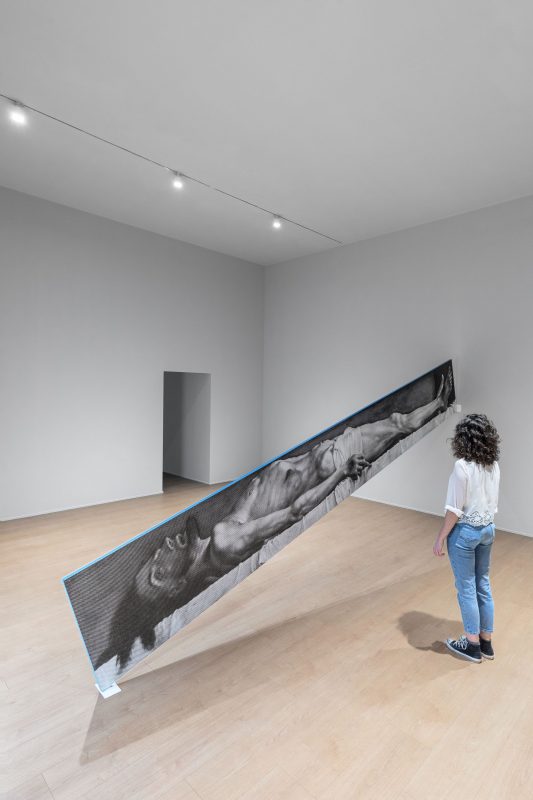
photography by © Delfino Sisto Legnani and Marco Cappelletti. Courtesy Fondazione Pradao Sisto Legnani and Marco Cappelletti.
Since the opening of Fondazione Prada’s new venue in 2015, the collection has become one of the available tools for the development of the foundation’s cultural program, taking different configurations – from thematic to collective shows, from anthological exhibitions to artist-curated projects – and now finding in Torre its permanent exhibition space.
 Restaurant “Torre”, located on the sixth level of the new building, hosts original furnishing pieces from the “Four Seasons Restaurant” in New York, designed by Philip Johnson in 1958, elements from Carsten Höller’s installation The Double Club (2008-2009), three sculptures by Lucio Fontana – two glazed polychrome ceramics Cappa per caminetto (1949) and Pilastro (1947) and a glass paste mosaic and cement Testa di Medusa (1948-54) – as well as a selection of paintings by William N. Copley, Jeff Koons, Goshka Macuga and John Wesley. Inspired by the tradition of the Italian restaurant, the walls display artists’ plates specially created for the restaurant by John Baldessari, Thomas Demand, Nathalie Djurberg & Hans Berg, Elmgreen & Dragset, Joep Van Lieshout, Goshka Macuga, Mariko Mori, Tobias Rehberger, Andreas Slominski, Francesco Vezzoli and John Wesley.
Restaurant “Torre”, located on the sixth level of the new building, hosts original furnishing pieces from the “Four Seasons Restaurant” in New York, designed by Philip Johnson in 1958, elements from Carsten Höller’s installation The Double Club (2008-2009), three sculptures by Lucio Fontana – two glazed polychrome ceramics Cappa per caminetto (1949) and Pilastro (1947) and a glass paste mosaic and cement Testa di Medusa (1948-54) – as well as a selection of paintings by William N. Copley, Jeff Koons, Goshka Macuga and John Wesley. Inspired by the tradition of the Italian restaurant, the walls display artists’ plates specially created for the restaurant by John Baldessari, Thomas Demand, Nathalie Djurberg & Hans Berg, Elmgreen & Dragset, Joep Van Lieshout, Goshka Macuga, Mariko Mori, Tobias Rehberger, Andreas Slominski, Francesco Vezzoli and John Wesley.
The rooftop terrace was conceived as a flexible space hosting a bar. It is characterized by a black and white optical floor decoration and by a mirror-clad balustrade which creates a reflection effect, capable of visually erasing the barrier between the actual space and the 360° view on the city of Milan.
 Project Info:
Project Info:
Architects: OMA
Location: Largo Isarco, 2, 20139 Milano MI, Italy
Partners in Charge: Rem Koolhaas, Chris van Duijn, Federico Pompignoli
Area: 2000.0 m2
Project Year: 2018
Photographs: Bas Princen, Delfino Sisto Legnani and Marco Cappelletti
Project Name: Fondazione Prada Torre
- photography by © Bas Princen. Courtesy Fondazione Prada
- photography by © Bas Princen. Courtesy Fondazione Prada
- photography by © Bas Princen. Courtesy Fondazione Prada
- photography by © Bas Princen. Courtesy Fondazione Prada
- photography by © Bas Princen. Courtesy Fondazione Prada
- photography by © Bas Princen. Courtesy Fondazione Prada
- photography by © Bas Princen. Courtesy Fondazione Prada
- photography by © Bas Princen. Courtesy Fondazione Prada
- photography by © Delfino Sisto Legnani and Marco Cappelletti. Courtesy Fondazione Pradao Sisto Legnani and Marco Cappelletti.
- photography by © Delfino Sisto Legnani and Marco Cappelletti. Courtesy Fondazione Prada
- photography by © Delfino Sisto Legnani and Marco Cappelletti. Courtesy Fondazione Prada
- photography by © Delfino Sisto Legnani and Marco Cappelletti. Courtesy Fondazione Prada
- photography by © Delfino Sisto Legnani and Marco Cappelletti. Courtesy Fondazione Prada
- photography by © Delfino Sisto Legnani and Marco Cappelletti. Courtesy Fondazione Prada
- photography by © Delfino Sisto Legnani and Marco Cappelletti. Courtesy Fondazione Prada
- photography by © Delfino Sisto Legnani and Marco Cappelletti. Courtesy Fondazione Pradao Sisto Legnani and Marco Cappelletti.
- photography by © Delfino Sisto Legnani and Marco Cappelletti. Courtesy Fondazione Pradao Sisto Legnani and Marco Cappelletti.
- photography by © Delfino Sisto Legnani and Marco Cappelletti. Courtesy Fondazione Pradao Sisto Legnani and Marco Cappelletti.
- photography by © Bas Princen. Courtesy Fondazione Prada
- photography by © Bas Princen. Courtesy Fondazione Prada
- photography by © Bas Princen. Courtesy Fondazione Prada
- photography by © Bas Princen. Courtesy Fondazione Prada
- photography by © Bas Princen. Courtesy Fondazione Prada
- photography by © Bas Princen. Courtesy Fondazione Prada
- East Facade © OMA
- North Facade © OMA
- Section © OMA
- Level 0 Plan © OMA
- Level 1 Plan © OMA
- Level 2 Plan © OMA
- Level 3 Plan © OMA
- Level 4 Plan © OMA
- Level 5 Plan © OMA
- Level 6 Plan © OMA
- Level 7 Plan © OMA
- Level 8 Plan © OMA
- Level 9 Plan © OMA
- Level 10 Plan © OMA


